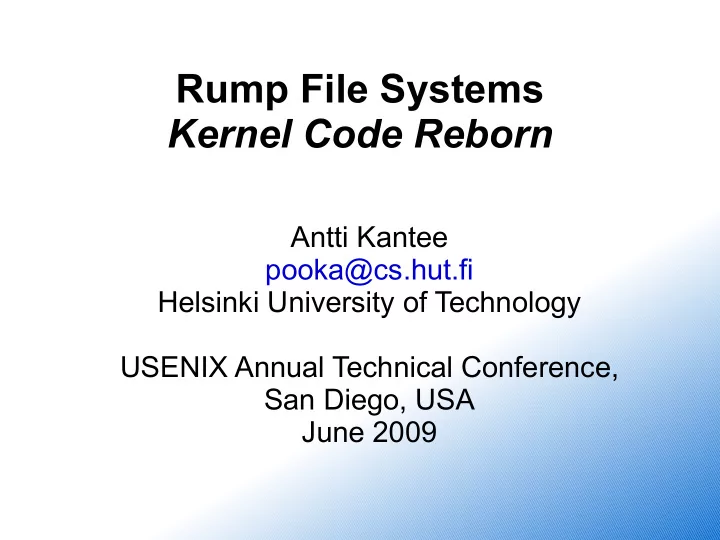

Rump File Systems Kernel Code Reborn Antti Kantee pooka@cs.hut.fi Helsinki University of Technology USENIX Annual Technical Conference, San Diego, USA June 2009
Introduction ● kernel / userspace dichotomy – interfaces dictate environment ● make kernel file systems run in userspace in a complete and maintainable way – full stack, no code forks or #ifdef ● file system is a protocol translator – read(off,size,n) => blocks 001,476,711,999
Implementation status ● NetBSD kernel file system code runs unmodified in a userspace process ● total of 13 kernel file systems – cd9660, efs, ext2fs, fat, ffs, hfs+, lfs, nfs, ntfs, puffs, sysvbfs, tmpfs, udf – disk, memory, network, ”other” ● implementation shipped as source and binary with NetBSD 5.0 and later
Terminology rump: runnable userspace meta program 1) userspace program using kernel code 2) framework which enables above rump kernel: part of rump with kernel code host (OS): system running the rump(1)
Talk outline motivation use cases implementation evaluation
Motivation ● original motivation: kernel development ● additional benefits: – security – code reuse in userspace tools – kernel code reuse on other systems
Contrasts 1)usermode OS, emulator, virtual machine, second machine, turing machine, etc. – acknowledge that we already have an OS – vm simplifications, abstraction shortcuts, etc. – direct host service (no additional userland) 2)userspace file systems (e.g. FUSE) – reuse existing code, not write new code against another interface
Talk outline motivation use cases implementation evaluation
Two modes mounted server application library (transparent, privileges) (explicit, unpriviledged) process 1 process 2 process 1 rump rump application kernel fs kernel fs userspace application file server user kernel syscall userspace file system
Security ● common scenario: you get a USB stick from a 3rd party ● plug stick into your system and attempt to either read or write files ● suitably corrupt file system: crash – or worse ● mount as rump file system: isolate damage to a process
Security ● common scenario: you get a USB stick from a 3rd party ● plug stick into your system and attempt to either read or write files ● suitably corrupt file system: crash kernel – or worse X ● mount as rump file system: isolate damage to a process file server, kernel fs
Development & Debugging ● kernel hacking is ... convoluted – kernel hackers already know this ● rump allows more details from non-expert user submitting bug report – very important in an open source context – users are rarely willing or in a situation to setup a kernel development environment
Tools: fs-utils ● mtools, ntfsprogs, ltools, etc. – self-contained apps to access fs in userspace – different syntax – file system driver reimplementation ● fs-utils (Ysmal 2008) – standard POSIX utilities, rump fs driver – examples: fsu_ls /dev/sd0e -ltr – fsu_mkdir fs.img -p /my/hier
Tools: makefs ● problem: create an installation image – crossbuild => cannot use in-kernel fs & mount ● solution: makefs (Mewburn 2001) – application which creates a file system image from a directory tree – modified copy of the FFS driver, >100h effort ● rump makefs uses fs-utils – more supported file systems, much less effort
Talk outline motivation use cases implementation evaluation
Kernel Code ● almost all kernel code can run anywhere ● set of interfaces code depends on determines default environment – malloc() vs. kmem_alloc() ● dependees have own set of dependencies ● need to find dependency closure starting from file system code
Implementation Strategy ● use as much kernel code directly as is practical ● use high-level services provided by host – threading, synchronization, sockets, etc. ● alter system structure: regroup source modules to minimize dependency hazards – but avoid getting yelled at
Finding Closure vfs pseudo virtual routines file systems memory memory atomic ops allocator thread file system locking scheduling support buffer disk driver cache host service name string cache manipulation reimplemented
Talk outline motivation use cases implementation evaluation
Maintenance ● implementation duplicates interfaces and relies on module boundaries ● how often does it break? entire kernel rump only rump rump breakage 0 1000 2000 3000 4000 5000 6000 7000 8000 9000 10000 commits repository analysis Aug 2007 – Dec 2008
Portability ”C is portable” ”userspace programs are portable” ● NetBSD and Linux fs, mix&match ● there are details to take into account – data types need to match ”userland”, rump fs, foo(time_t *) OS ... y, NetBSD x+1, 32bit time_t 64bit time_t
Performance ● current approach: enhance performance only inside rump – do not modify the host system to provide non- standard interfaces ● for ultraperformance, use in-kernel mount ● common rump performance for FFS is ± 5% of kernel mount performance – depends on backend
Conclusions ● possible to run kernel fs code of a general purpose OS in userspace – alter system structure ● benefits – avoid reimplementations – security – and kernel development ● implement it on $YourOS ;-)
Try it out! ● go to http://www.NetBSD.org/ ● download 5.0 or -current & install – or use LiveCD ● man rump ● submit bug reports
Try it out! ● go to http://www.NetBSD.org/ ● download 5.0 or -current & install – or use LiveCD ● man rump ● submit bug reports Questions?
Recommend
More recommend